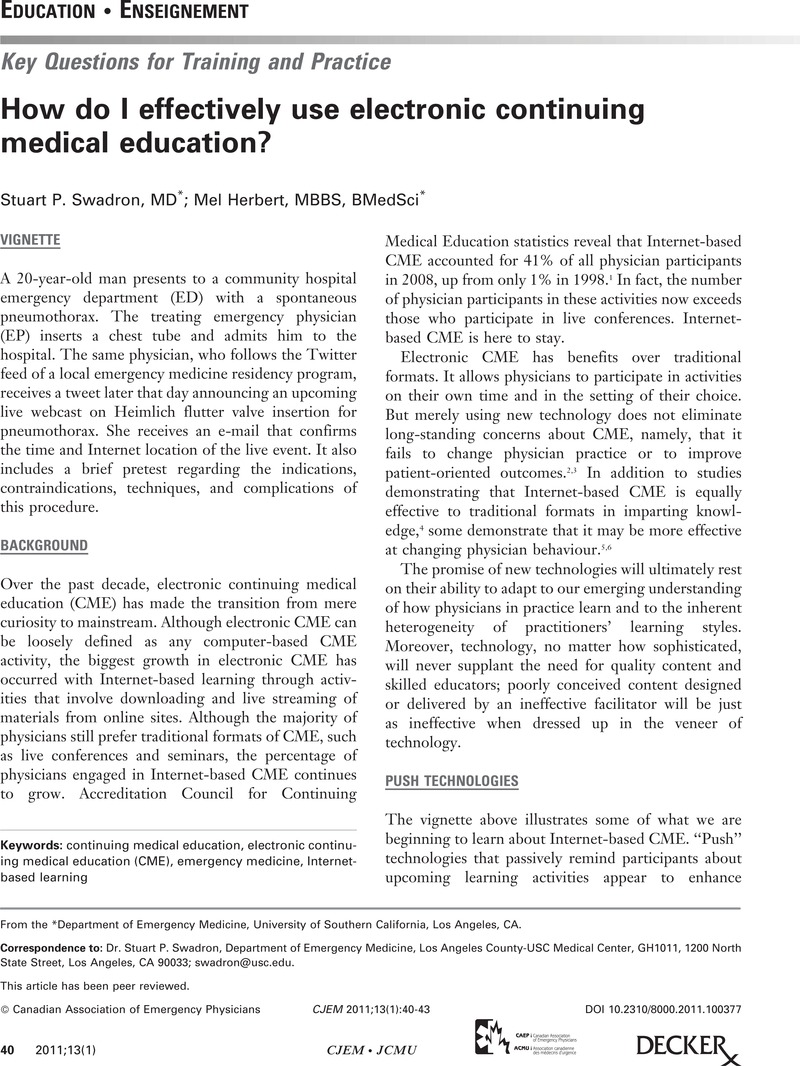No CrossRef data available.
Article contents
How do I effectively use electronic continuing medical education?
Published online by Cambridge University Press: 11 May 2015
Abstract
An abstract is not available for this content so a preview has been provided. As you have access to this content, a full PDF is available via the ‘Save PDF’ action button.

Keywords
- Type
- Education • Enseignement
- Information
- Copyright
- Copyright © Canadian Association of Emergency Physicians 2011
References
REFERENCES
1.Accreditation Council for Continuing Medical Education. ACCME annual reports 1998–2008. Available at: http://www.accme.org/index.cfm/fa/home.popular/popular_id/127a1c6f-462d-476b-a33a-6b67e131ef1a.cfm (accessed February 9, 2010).Google Scholar
2.Davis, D, Thomson, MA, Oxman, AD, et al. Changing physician performance. A systematic review of the effect of continuing medical education strategies. JAMA 1995;274:700–5.CrossRefGoogle ScholarPubMed
3.Davis, D, O’Brien, MA, Freemantle, N, et al. Impact of formal continuing medical education: do conferences, workshops, rounds, and other traditional continuing education activities change physician behavior or health care outcomes? JAMA 1999;282:867–74.CrossRefGoogle ScholarPubMed
4.Wutoh, R, Boren, SA, Balas, EA. eLearning: a review of Internet-based continuing medical education. J Contin Educ Health Prof 2004;24:20–30.Google Scholar
5.Weston, CM, Sciamanna, CN, Nash, DB. Evaluating online continuing medical education seminars: evidence for improving clinical practices. Am J Med Qual 2008;23:475–83.Google Scholar
6.Fordis, M, King, JE, Ballantyne, CM, et al. Comparison of the instructional efficacy of Internet-based CME with live interactive CME workshops: a randomized controlled trial. JAMA 2005;294:1043–51.CrossRefGoogle ScholarPubMed
7.Abdolrasulnia, M, Collins, BC, Casebeer, L, et al. Using email reminders to engage physicians in an Internet-based CME intervention. BMC Med Educ 2004;4:17.Google Scholar
8.Boulos, MN, Wheeler, S. The emerging Web 2.0 social software: an enabling suite of sociable technologies in health and health care education. Health Info Libr J 2007;24:2–23.Google Scholar
9.Sargeant, J, Curran, V, Jarvis-Selinger, S, et al. Interactive online continuing medical education: physicians’ perceptions and experiences. J Contin Educ Health Prof 2004;24:227–36.Google Scholar
10.Sargeant, J, Curran, V, Allen, M, et al. Facilitating interpersonal interaction and learning online: linking theory and practice. J Contin Educ Health Prof 2006;26:128–36.CrossRefGoogle ScholarPubMed
11.Fox, RD, Bennett, NL. Learning and change: implications for continuing medical education. BMJ 1998;316:466–8.Google Scholar
12.Guan, J, Tregonning, S, Keenan, L. Social interaction and participation: formative evaluation of online CME modules. J Contin Educ Health Prof 2008;28:172–9.Google Scholar


